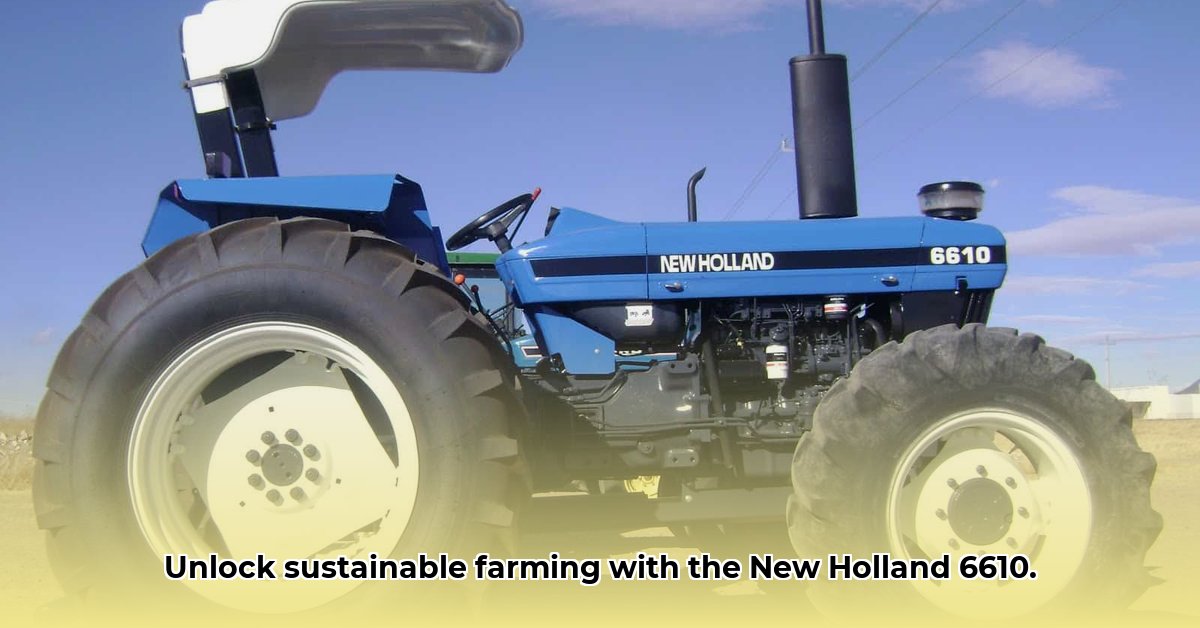
The New Holland 6610: a stalwart of the fields, but is it the right fit for your sustainable farming operation? This detailed review, combined with a practical guide, will help you decide. We'll examine its capabilities, limitations, and how to optimize its use for eco-friendly farming. For more on New Holland tractors generally, check out this helpful resource: New Holland tractors.
Engine Performance and Fuel Efficiency
The 6610 boasts a powerful 4.4L four-cylinder diesel engine. However, its fuel consumption can be relatively high compared to modern tractors. That 21-gallon fuel tank might require frequent refills, especially during peak seasons. To maximize fuel efficiency:
- Optimize Routes: Plan efficient field routes to minimize unnecessary travel.
- Tire Pressure: Maintain correct tire inflation; under-inflation increases rolling resistance and fuel consumption.
- Regular Maintenance: Regular oil changes and filter replacements ensure optimal engine performance and fuel economy.
- Consider Biodiesel: Explore the use of biodiesel (if compatible and available) as a more sustainable fuel alternative.
Calculating Fuel Consumption: To estimate fuel consumption per hectare, track fuel levels before and after specific tasks, noting the area covered. This provides a valuable benchmark, though precise figures are difficult to obtain for this older model. Remember that this is an approximation, useful for comparison rather than exact accounting.
Technological Capabilities and Limitations
The 6610 excels at fundamental tasks like tilling and hauling, offering decent rear lift capacity and PTO capabilities. However, it lacks the advanced features of modern tractors, such as GPS guidance and precision sensors for tasks like fertilizer application.
This "simplicity" is both a benefit and a drawback. While reducing initial investment and complexity, it requires more manual operation and potentially supplementary tools for precision farming practices. This might necessitate adapting farming techniques to compensate for the tractor's technological limitations.
Sustainable Farming Practices with the 6610
The 6610 is well-suited for smaller-scale operations emphasizing sustainable practices. Its power is well-matched to reduced or no-till farming, minimizing soil disturbance and conserving moisture. Precision fertilization, however, might require additional equipment to compensate for the tractor's lack of automated systems.
Maintenance, Repairs, and Parts
Proactive maintenance is crucial for an older tractor like the 6610. Regular oil changes, filter replacements, and thorough system checks are vital. Establishing a relationship with a mechanic experienced with older models is highly recommended. Consider purchasing commonly-needed parts in advance to minimize downtime during repairs. Finally, remember responsible recycling or disposal of parts at end-of-life.
Sustainability Assessment: A Holistic View
While precise data on the 6610's environmental impact is scarce, its longevity reduces the environmental burden of frequent tractor replacements. Its relatively simple mechanics simplify maintenance, further minimizing waste. However, it's essential to weigh the potential for higher fuel consumption per acre against its longevity and lower initial cost.
Actionable Steps for Farmers
Here's a step-by-step guide to help you decide if the New Holland 6610 is right for your farm:
- Assess Needs: Thoroughly examine your farm's size, tasks, and specific requirements.
- Compare Costs: Conduct a detailed cost analysis including purchase price, operating costs (fuel and maintenance), and potential additional equipment.
- Implement a Maintenance Plan: Develop a comprehensive and strictly adhered to maintenance schedule.
- Secure Parts Sources: Identify reliable sources for replacement parts to avoid delays during repairs.
- Enhance Capabilities: Investigate supplemental equipment to compensate for the tractor's technological limitations.
Weighing the Pros and Cons
| Pros | Cons |
|---|---|
| Lower initial cost | Higher ongoing maintenance costs |
| Relatively fuel-efficient (for its age) | Limited advanced technological features |
| Suitable for reduced or no-till farming | Parts sourcing can be challenging |
| Mechanically simple | Uncertain long-term environmental impact |
Remember: Always comply with local regulations concerning emissions, safety, and proper disposal of parts and fluids. This guide offers valuable insights, but detailed research tailored to your specific needs is essential. Consider consulting agricultural experts and reviewing relevant regulations for your region.